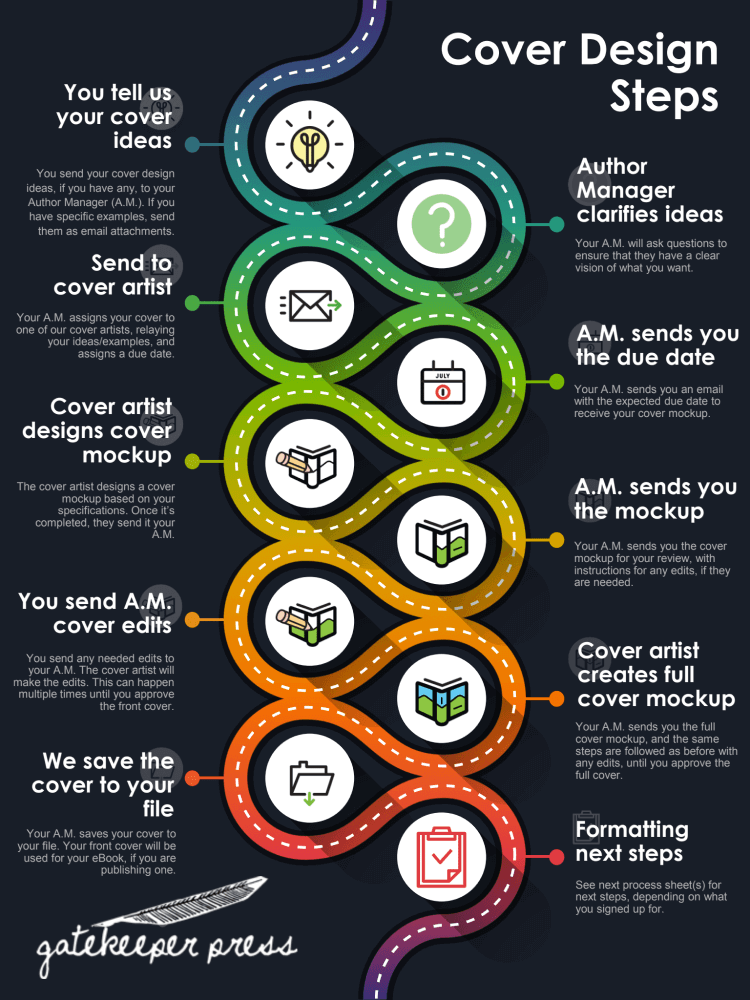While you supposedly can’t judge a book by its cover, there is no denying the importance of a visually impactful cover design. No matter how much time and attention is devoted to the interior parts of a book, an author is well advised to understand that its cover is a powerful marketing tool.
With this in mind, what exactly makes a good book cover anyway? Should your cover design be bold and dramatic? Should it be crisp and clean? Does the font choice matter? What book cover size should you use?
These and many more design elements are critical when deciding on the aesthetic container of your literary masterpiece, i.e., the book cover.
What Makes a Good Book Cover?
We know a good book cover when we see one, right? These are the books that entice us to reach out and pick up the book in a brick and mortar store, or to click on the image to check out the “Look Inside” excerpts in a digital marketplace. Our initial attraction to the book is likely due to its compelling cover design.
As an inspiring author, you want your book cover to fire on all cylinders. The power of the cover design to motivate sales cannot be overstated, and it has just mere seconds to accomplish that goal. Ask yourself if your cover has the following attributes:
- It communicates the theme, genre, and tone of the book.
- It evokes emotion or reaction.
- It is visually balanced.
- It is understandable.
- It is appropriate to the genre.
- It is visually appealing even as a thumbnail.
General Book Cover Design Tips
Designing a captivating book cover is equal parts creativity and adherence to design standards. When these two elements come together in perfect harmony the result is a cover that will attract attention and thereby increase sales volume. To achieve this lofty goal there are some important steps to take. To design a good book cover, you must:
- Determine what you want the cover to convey, what story it tells.
- Decide on a color palette.
- Create an attention-grabbing image or visual focal point.
- Select two compatible fonts to convey title, subtitle, and author. Certain genres are associated with particular fonts.
- Create a cover design that is easy to understand and readable in thumbnail size.
- Balance the composition elements.
Back Book Cover Design Tips
Consider the back cover a promotional device, offering important details about the content, author, and featuring reviews or awards received. Even though the back cover focuses on text, design is still important. The visuals that are featured on the cover will wrap around to the back cover to some extent. Consider these tips for your back book cover design:
- Write a compelling blurb about your book. This is equivalent to the ten-second elevator pitch that piques interest and inspires the person to buy the book to learn more. The blurb should be appropriate for its genre, such as asking questions and imparting information for nonfiction, or give an intriguing hint at the plot for fiction.
- Write a compact author bio. Keep it short and sweet.
- Include testimonials. If you have secured some reviews from a fellow author or someone in a prominent position in your chosen field, include two or three short blurbs. Be sure to emphasize the credentials of the person who wrote it.
Fiction Book Cover Design Tips
What kind of cover should you design if your book is a thriller, science fiction, dystopian, or fantasy-themed book? You can imagine that fiction book cover design will have lots of room for creativity and intrigue! Keep these tips in mind for designing the perfect fiction book cover:
- Know your audience. A young adult reader will be attracted to a vastly different aesthetic than an adult reader.
- Graphics should evoke the essence of the story. Is it edgy, fantastical, suspenseful, or atmospheric?
- Colors tend to be more dramatic for fiction book covers, although some adeptly use black and white for a stunning effect.
Romance Book Cover Design Tips
If there is one genre that has a predictable book cover design format it is the romance category. An author is wise to respect the established formula and just add your own creative flair to it. The romance cover design will feature, of course, the lovers depicted in the story. To create a provocative romance book cover, consider these tips:
- Decide whether you will depict the full figure, only the faces, or just a specific body part, say the lips or the feet, of the characters on the cover.
- Decide if the characters will be overtly entwined or to go with a more subtle pose.
- Ensure the imagery, color palette, and font evokes passion. More traditional romance novels use softer colors, where erotic novels tend to use deep, rich colors.
Poem Book Cover Design Tips
A book of poems is a creative literary work. This allows for a wide range of leeway from the restrictions of any standardized formulas, such as what the romance genre is beholden to. An author of poetry may decide on a cover that is more conceptual versus literal, or they may elect to convey a visual depiction of the poetry collection’s theme. For poem book cover design success, keep these tips in mind:
- The cover design should evoke an emotion related to the theme.
- Keep the design clean and simple.
- Make good use of white space.
Self-Help Book Cover Design Tips
A nonfiction self-help book will likely follow the expectations for most other books in the nonfiction genre. Successful self-help books tend to have covers that evoke a sense of authority and trust, although many also use the element of humor. Self-help book cover designs also tend to be simplified and use larger font size for the titles. Keep in mind the following design tips for your self-help book:
- Make sure the book title clearly defines the purpose of the book.
- The design should reflect the audience, such as gender and age of the reader.
- An informative and concise subtitle is essential to defining the book’s theme.
Work With the Experts to Create the Perfect Book Cover
Coming up with a compelling book cover design can be one of the more challenging steps in the self-publishing process. A publishing team like Gatekeeper Press can assist you in designing the book cover’s size, selecting the font and color palette, the overall visual theme and composition, and guidance on the back cover content. Reach out to us today!


